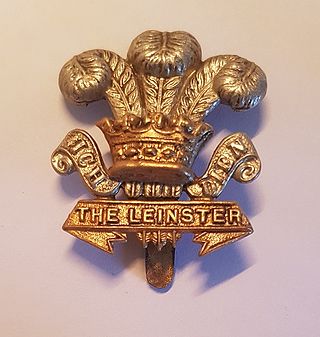
General Sir John Coape Sherbrooke, was a British soldier and colonial administrator. After serving in the British army in Nova Scotia, the Netherlands, India, the Mediterranean, and Spain, he was appointed Lieutenant-Governor of Nova Scotia in 1811. During the War of 1812, his policies and victory in the conquest of present-day Maine, renaming it the colony of New Ireland, led to significant prosperity in Nova Scotia.
The New South Wales Corps, later known as the 102d Regiment of Foot, and lastly as the 100th Regiment of Foot, was a formation of the British Army organised in 1789 in England to relieve the New South Wales Marine Corps, which had accompanied the First Fleet to New South Wales. In Australia, the New South Wales Corps gained notoriety for its trade in rum and mutinous behaviour.

The Capture of Fort Niagara took place 18-19 December 1813 during the War of 1812 between Great Britain and the United States. The American garrison was taken by surprise, and the fort was captured in a night assault by a select force of British regular infantry.
The 89th Regiment of Foot was a regiment of the British Army, raised on 3 December 1793. Under the Childers Reforms the regiment amalgamated with the 87th Regiment of Foot to form the Princess Victoria's in 1881.
The 41st (Welch) Regiment of Foot was an infantry regiment of the British Army, raised in 1719. Under the Childers Reforms it amalgamated with the 69th Regiment of Foot to form the Welch Regiment in 1881.
The 82nd Regiment of Foot (Prince of Wales's Volunteers) was an infantry regiment of the British Army, raised in 1793. Under the Childers Reforms it amalgamated with the 40th (the 2nd Somersetshire) Regiment of Foot to form the Prince of Wales's Volunteers (South Lancashire Regiment) in 1881.

The Prince of Wales's Leinster Regiment (Royal Canadians) was an infantry regiment of the line in the British Army, formed in 1881 by the amalgamation of the 100th (Prince of Wales's Royal Canadian) Regiment of Foot and the 109th Regiment of Foot (Bombay Infantry). The 100th Foot was first raised in 1858 and the 109th was first raised in 1853. Between the time of its formation and Irish independence, it was one of eight Irish regiments raised largely in Ireland, with its Birr Barracks home depot in Birr. It was disbanded with the Partition of Ireland following establishment of the independent Irish Free State in 1922 when the five regiments that had their traditional recruiting grounds in the counties of the new state were disbanded.

The 100th Regiment of Foot was a British Army regiment, raised in 1858. Under the Childers Reforms it amalgamated with the 109th Regiment of Foot to form the Prince of Wales's Leinster Regiment in 1881.
The 58th (Rutlandshire) Regiment of Foot was a British Army line infantry regiment, raised in 1755. Under the Childers Reforms it amalgamated with the 48th (Northamptonshire) Regiment of Foot to form the Northamptonshire Regiment in 1881.
The 62nd (Wiltshire) Regiment of Foot was an infantry regiment of the British Army, which was raised in 1756 and saw service through the eighteenth and nineteenth centuries. Under the Childers Reforms it amalgamated with the 99th (Lanarkshire) Regiment of Foot to form the Wiltshire Regiment in 1881.
The 83rd Regiment of Foot was a British Army line infantry regiment, which was formed in Ireland in 1793 for service in the French Revolutionary Wars. The regiment served in the West Indies, South Africa and the Peninsular War, and after the end of the wars with France spent much of the nineteenth century in colonial garrisons. Among other service, the 83rd fought in the Ceylon Great Rebellion of 1817–18, the Canadian Rebellions of 1837, and the Indian Rebellion of 1857. Under the Childers Reforms, the regiment amalgamated with the 86th Regiment of Foot to form the Royal Irish Rifles in 1881.
Sir Frederick John Falkiner, 1st Baronet was an Irish baronet and politician.

The Battle of Buffalo took place during the War of 1812 on December 30, 1813, in the State of New York, near the Niagara River. The British forces drove off the American defenders and destroyed many buildings and ships. The operation was retaliation for American troops burning the Canadian village of Newark.
Lt.-Colonel Henry Peard Driscoll (1792-1869) Q.C., J.P., was an Anglo-Irish officer court-martialled and discharged from the British Army at Montreal. Remaining there he edited two newspapers and became well known as a lawyer, poet and wit.

Richard Smith was a Canadian soldier who fought in the War of 1812 for the 104th Regiment of Foot.
The 103rd Regiment of Foot was a line infantry unit of the British Army. Though only existing for just over 10 years, the regiment would see more action than most of its 100-series regiments.

The Royal Irish Regiment of Foot Guards, or His Majesty’s Regiment of Guards in Ireland, was a regiment of foot guards first raised in 1662 for service in Ireland. Part of the Irish Army of Charles II, it was initially garrisoned around Dublin.
104th Regiment of Foot was a regiment of the British Army. The regiment had its origins in the New Brunswick Regiment of Fencible Infantry, a unit of fencibles raised for the defence of the colony of New Brunswick in 1803. Recruits were drawn from across British North America, Scotland, Ireland and existing British Army units. The regiment was formally entered into the establishment in 1806 with a strength of around 650 enlisted men but grew to almost 1,100 by 1808. In 1810 the regiment's officers requested that it join the British Army as a regiment of foot. This request was granted on 13 September 1810 and the unit was renamed the 104th Regiment of Foot.







